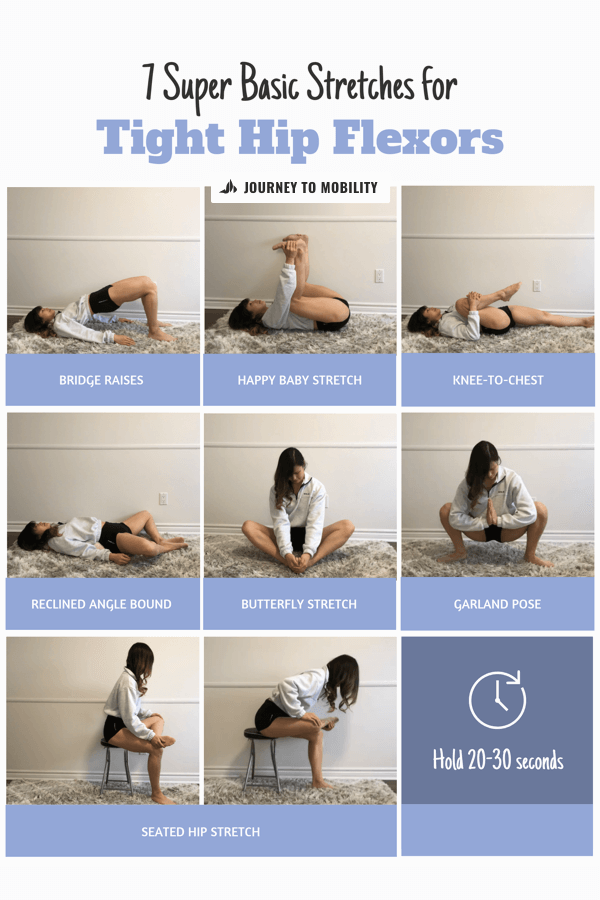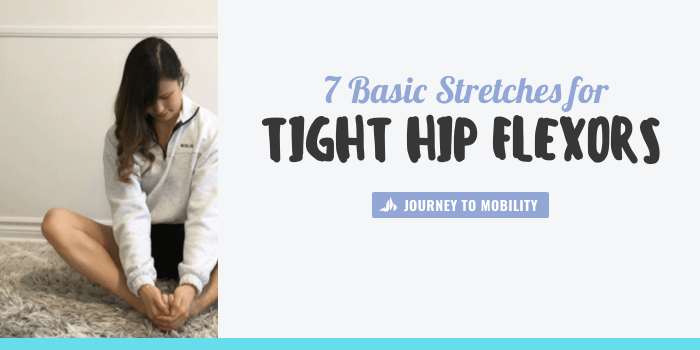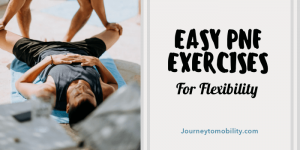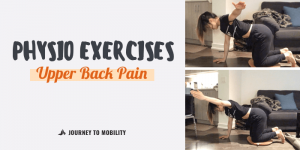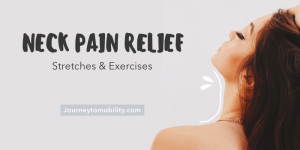A lot of people experience tightness in their hips. You use your hips when you stand up from a seated position, while you’re walking, running, or jumping. My hips were very tight when I first started stretching. I remember feeling a tugging sensation in my hips and thighs. Now, I stretch tight hip flexors everyday and the results have been incredible. Here are some basic stretches that you can add to your morning or night routine to open up those tight hips.
If your hips are tight, this means that there’s tension around the hip flexors. The hip flexors are a group of muscles that cross over the hip joint, connecting lower spine and the inside of the pelvis to the upper thigh. Tight hip flexors can cause pain in your lower back, in your hip and groin area or even your knees. Read to learn about what hip flexors are and 7 basic stretches you can do to improve your hip mobility.
Overview
- What are your Hip Flexors?
- 7 Basic Stretches for Tight Hips
- What Causes Tight Hips?
- What Are the Symptoms of Tight Hip Flexors
- Thomas Test: How Do You Know If Your Hips Are Tight?
Beginner Hip Stretches:
Beginner/Intermediate:
What are your Hip Flexors?
The hip flexors are a group of muscles deep within the hips. You can locate your hip flexors by placing your hands on the front where your hips meet your upper thighs. These muscles allow you to bring your knee up towards your chest and bend over at your waist.
Muscles in the Hip Flexors Include:
- the iliopsoas which contains the iliacus and psoas major muscles
- the rectus femoris, located in the quadriceps
- the tensor fasciae latae
- the sartorius
When your hip flexors are tight, it’s harder for your pelvis to move and properly rotate. This can cause your lower back to overcompensate which is a “setup for lower-back injury,” explains Teo Mendez, M.D., an orthopedic surgeon at NY Orthopedics (1). To alleviate pain in your hips, you must do exercises that target muscles in your hip flexors.
Doing hip flexor stretches everyday has improved my overall mobility. I am now able to easily bring my knees to my chest, bend past 90 degrees from the waist and do the splits!

7 Basic Stretches for Tight Hip Flexors
Practice this routine daily and take it slow. Move slowly in and out of the poses as you breathe.
1) Bridge Raises
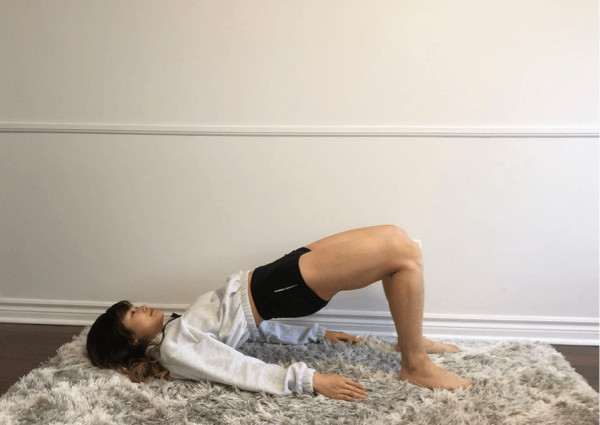
A basic bridge raise stretches the chest, spine, and hip while strengthening muscles in the lower back, glutes, and hamstrings. You may choose to do a supported bridge pose by placing a yoga block beneath your pelvis. Yoga blocks can be set up at three different heights. Find a height that feels good for your body to modify.
- Lay down with your back on the mat, your hands by your sides.
- Bend your knees and plant your feet flat on the ground. Your knees should be directly above your ankles.
- Keep your core tight and glutes engaged as you press your hips up towards the ceiling. Press your heel against the ground as you hold the lifted position to make this an active stretch.
- Breathe and hold for 20 seconds. Reset by lowering your pelvis to the ground and repeat for 5 reps.
2) Happy Baby Stretch
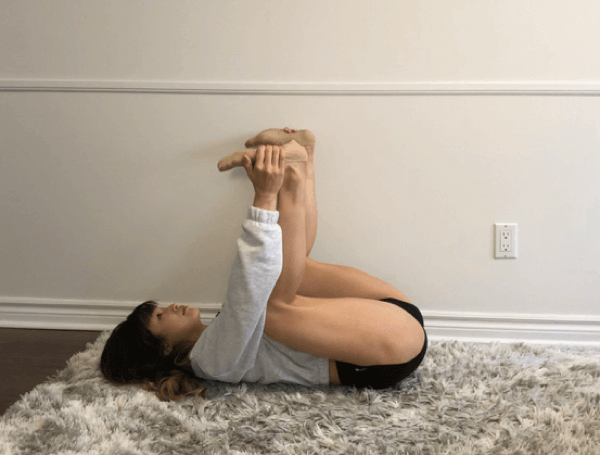
This stretch releases tension in the lower back and sacrum. It opens up the hips, inner thighs, and groin. Rocking your body side-to-side also stretches and soothes the spine. This is a bed-friendly stretch to do in the morning or before going to bed.
- Lay down with your back on the mat, bring both knees towards your chest.
- With two fingers (pointer finger and middle finger), grab onto both toes. You can also grab the outside of your feet if this feels more comfortable.
- Bring your feet up to face the ceiling. Your legs should both be bent at 90 degrees, ankle directly above your knees.
- Gently rock your body side-to-side for 30 seconds. Pull your feet towards your body as you rock from one side to the other.
3) Lying Knee-to-Chest Stretch
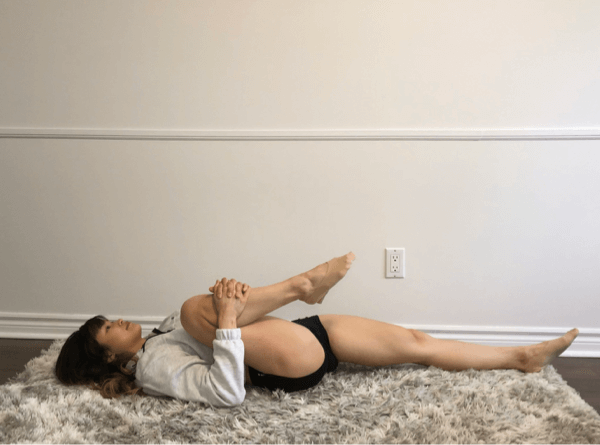
This is a simple exercise that stretches and strengthens the lower back, glutes and hips. You can do this stretch in the morning before getting out of bed to help wake up your body. Over time, you should be able to get you knees a little closer to your chest as your hip flexors lengthen.
- Lay down with your back on the mat, hug your right knee towards your chest.
- Gently pull your knee towards the chest on each exhale.
- Breathe and hold for 30 seconds, as you actively hug your knee a little closer to the chest each time. Repeat on the other side.
4) Reclining Angle Bound Pose
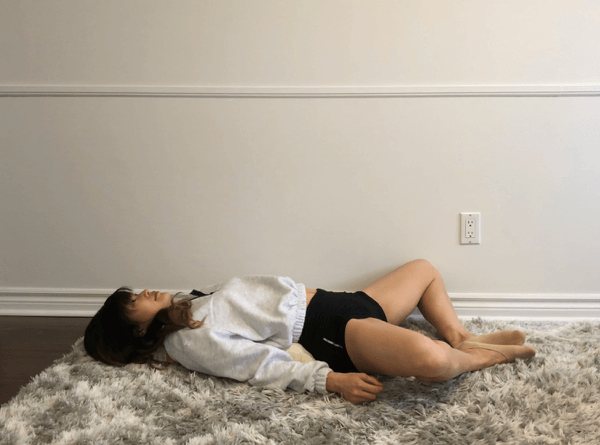
This is a restorative yoga pose that helps with blood circulation in the lower body, stretches the inner thighs and increases range of external rotation in the hips (4). This is a relaxing stretch you can do before going to bed.
- Lay down with your back on the mat. You may choose to place blankets under your back and the sides to rest your knees on.
- Place your feet together, knees opening out.
- Breathe and hold for up to 60 seconds.
5) Butterfly Stretch
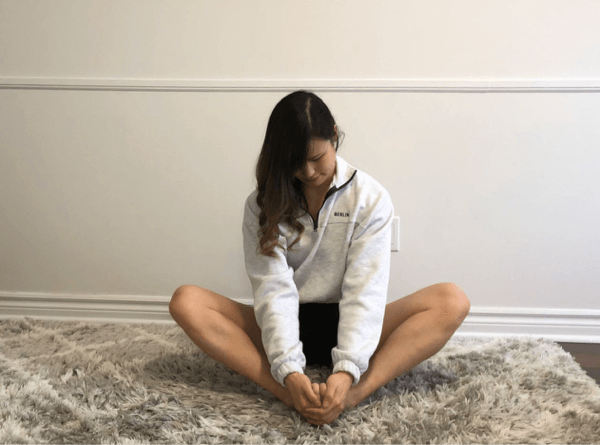
The Butterfly stretch opens up the hips by stretching the hip adductors, muscles in your inner thighs. Stretching these muscles helps maintain optimal function and movement of the hips. You can do this stretch after a lower body workout or after a run.
- Sit on the ground with your feet together and your knees apart.
- Hold your feet as you actively press both knees down towards the ground. Make adjustments -having your feet farther away will make it easier. Bringing both feet closer to the body will increase its intensity. If you still don’t feel the stretch, you can walk your hands in front and try to bring your stomach to the ground.
- Breathe and hold for 30 seconds.
6) Garland Pose
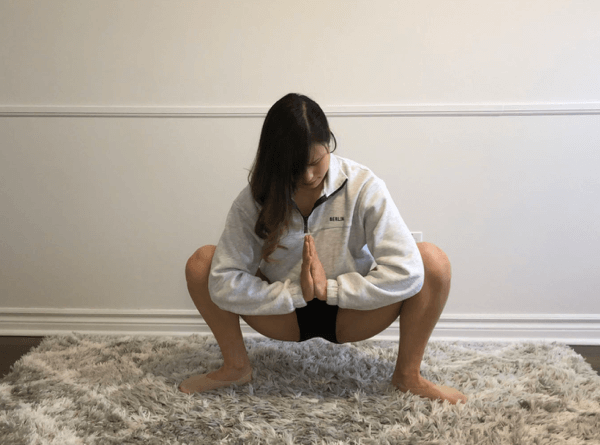
The Garland pose stretches the ankles, hips, groin and lower back. Use your elbows to actively push against the inside of your knees to open up the hips.
- Put your hands together in prayer position.
- Squat down with a straight spine, shoulders away from your ears.
- Use your elbows to press against the insides of the knees to open up your hips. This should increase the stretch in your hips and groin area. You can shift your weight from side-to-side or add gentle twists to further open your hips further.
- Breathe and hold for 30 seconds.
7) Seated Stretch
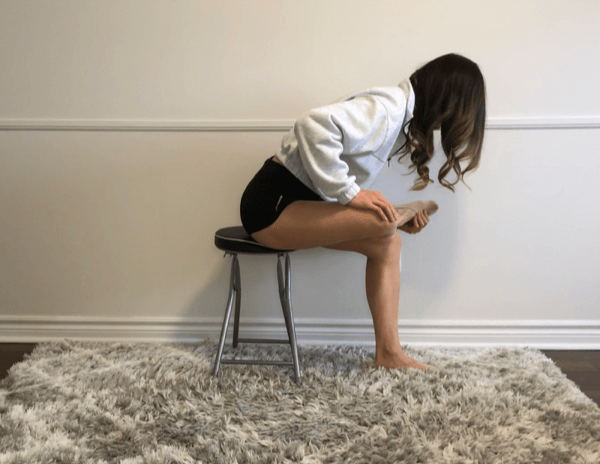
Do this stretch anytime you are sitting -while you’re working at your desk, watching television or in your airplane seat. You should feel this stretch around the groin, the outside of your hips and lower back.
- Sit on a chair with your back straight.
- Place your right ankle on your left knee -making sure that your ankle is positioned just below the knee (to prevent direct pressure on the knee).
- Fold your torso forward until you feel a gentle stretch.
- Hold for up to 60 seconds. Repeat on the other side.
What Causes Tight Hips?
The most common cause of tight hips is sitting for long periods of time. When we don’t stretch, the muscles in our hips become deactivated (2). Over time, the muscles around the hips become weak and shorten. We often don’t notice until we feel discomfort in our hips. Stretching reverses the effect of sitting by allowing the hip flexors and joints to elongate and move.
Causes for Hip Tightness:
- Sitting for prolonged period with a tipped pelvis (weight unevenly distributed).
- Postural habits while standing like leaning into one hip or leaning forward.
- Sleeping all night on the same side of the body.
- One leg longer than the other.
What are the Symptoms of Tight Hip Flexors?
If your hip flexors you may notice discomfort or pain in your hips when you sit or stand. Your hips could limit your ability to perform exercises correctly or do leg stretches.
Other Signs of Tight Hip Flexors:
- Tightness in your hip or groin area.
- Tightness or an ache in your lower back while sitting or standing.
- Poor posture and difficulty standing up straight.
- Neck tightness and pain.
- Pain in the glutes.
If your hips are tight, your pelvis may start to tilt forward which would increase the arch in your lower back. According to Charlee Atkins, C.S.C.S., instructor at Soul Annex in New York City (3), “people focus on the hips and say their hips are tight, but we don’t always think about the fact that the lower back connects to our legs at the hip”.
Thomas Test: How Do You Know If Your Hips Are Tight?
The Thomas Test is an easy way to access if your hip flexors are tight.
- Sit at the very edge of a bench or table and lay down.
- Bring both knees in towards your chest.
- Drop your left leg down with your lower back pressed against the bench. Check to see the position of your left leg.
Thomas Test Assessment
- Tight hip flexors – If the left thigh is lifting off the bench
- Tight quads – If your left leg is straight rather than bent at 90 degrees.
- Tensor Fasciae Latae (TFL muscle) is tight – If your leg is abducted or angled diagonally to the side.
Takeaway
To improve hip mobility, start by identifying if it’s your hips that are tight, then add these basic hip flexor stretches to your morning and night routine. This basic routine should take you about 10 minutes to do. More articles for how to strengthen and stretch hip flexors to come!
PS – Here’s a Pinterest-friendly image if you want to save this routine for later!
